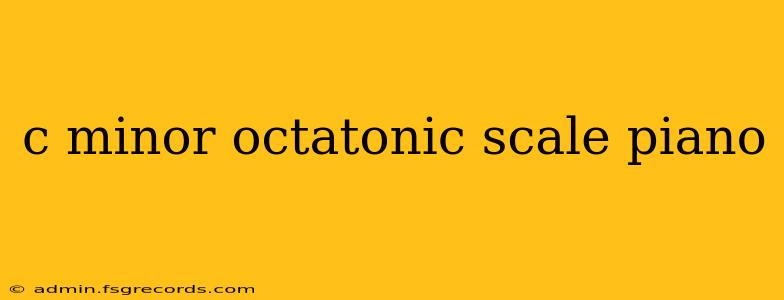The octatonic scale, with its unique and slightly unsettling sound, offers composers and improvisers a rich palette of musical possibilities. This guide will delve into the C minor octatonic scale, exploring its construction, characteristics, and practical applications on the piano. We'll uncover why it's a fascinating scale to master and how it can enhance your musical expression.
Understanding the Octatonic Scale
The octatonic scale, also known as the diminished scale, is an eight-note scale containing alternating whole and half steps. Unlike diatonic scales, it lacks a clear tonal center, leading to its ambiguous and often dramatic character. This characteristic makes it particularly useful for creating tension and exploring chromatic harmonies.
There are two forms of the octatonic scale: one built on whole and half steps (W-H-W-H-W-H-W-H), and the other built on half and whole steps (H-W-H-W-H-W-H-W). The C minor octatonic scale we'll focus on utilizes the whole-half pattern.
Constructing the C Minor Octatonic Scale
The C minor octatonic scale is constructed as follows:
C - D - Eb - F - F# - G# - A - B - C
Notice the alternating whole and half steps:
- C to D (whole step)
- D to Eb (half step)
- Eb to F (whole step)
- F to F# (half step)
- F# to G# (whole step)
- G# to A (half step)
- A to B (whole step)
- B to C (half step)
Playing the C Minor Octatonic Scale on the Piano
Playing this scale on the piano is straightforward. Start on C and follow the sequence above, ensuring you accurately identify the whole and half steps. Practice ascending and descending the scale smoothly, paying attention to evenness in your rhythm and articulation.
Fingerings
Efficient fingerings are crucial for fluid execution. Experiment with different fingerings to find what feels most comfortable and allows for smooth transitions between notes. A suggested fingering for the right hand is: 1-2-3-4-5-1-2-3. Adapt this as needed for your hand size and playing style.
Characteristics of the C Minor Octatonic Scale
The C minor octatonic scale possesses several key characteristics that distinguish it from diatonic scales:
- Ambiguity: Its lack of a clear tonal center creates a sense of ambiguity and instability.
- Chromaticism: The scale incorporates notes from both the major and minor scales, contributing to its rich chromatic character.
- Tension and Release: The alternating whole and half steps generate a unique tension that can be resolved effectively through careful harmonic choices.
- Modal Interchange: It borrows elements from various modes, allowing for flexible harmonic possibilities.
Musical Applications of the C Minor Octatonic Scale
The C minor octatonic scale finds applications in various musical contexts:
- Composition: It can form the basis of melodies, harmonies, and counterpoint, adding a unique flavor to your compositions.
- Improvisation: It provides a framework for improvising over chord progressions that share its notes. Experiment with different rhythmic and melodic approaches.
- Modern Music: The scale is particularly prevalent in jazz, avant-garde, and contemporary classical music.
Expanding Your Understanding
To fully grasp the potential of the C minor octatonic scale, consider these further explorations:
- Harmonic Analysis: Analyze how the scale interacts with different chords and progressions.
- Modal Mixture: Explore how the scale incorporates elements from other modes and scales.
- Compositional Exercises: Compose short pieces utilizing the C minor octatonic scale as the primary melodic and harmonic foundation.
By mastering the C minor octatonic scale and understanding its unique characteristics, you'll unlock a new dimension in your musical vocabulary, allowing you to create compelling and innovative music. Happy practicing!

